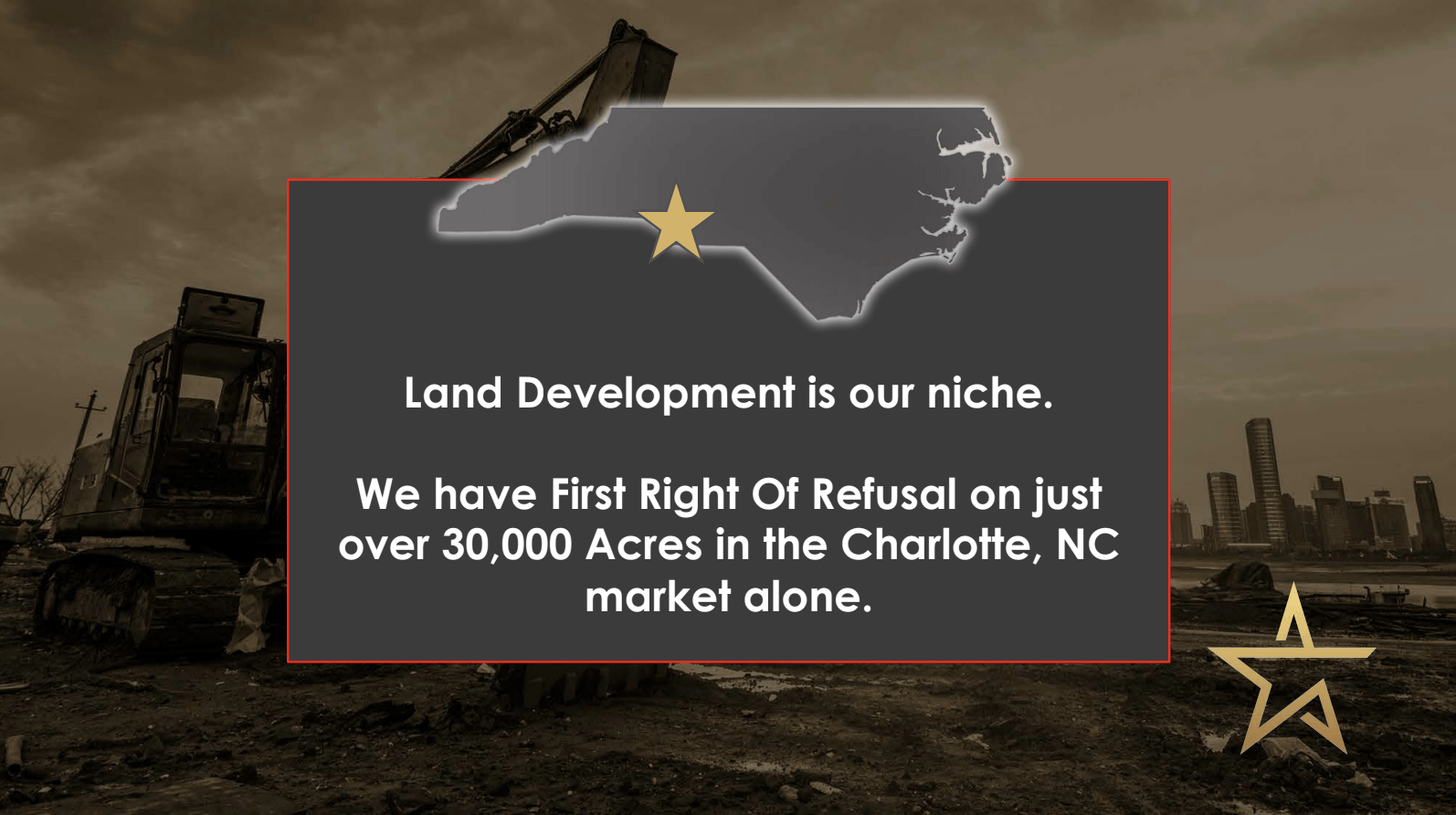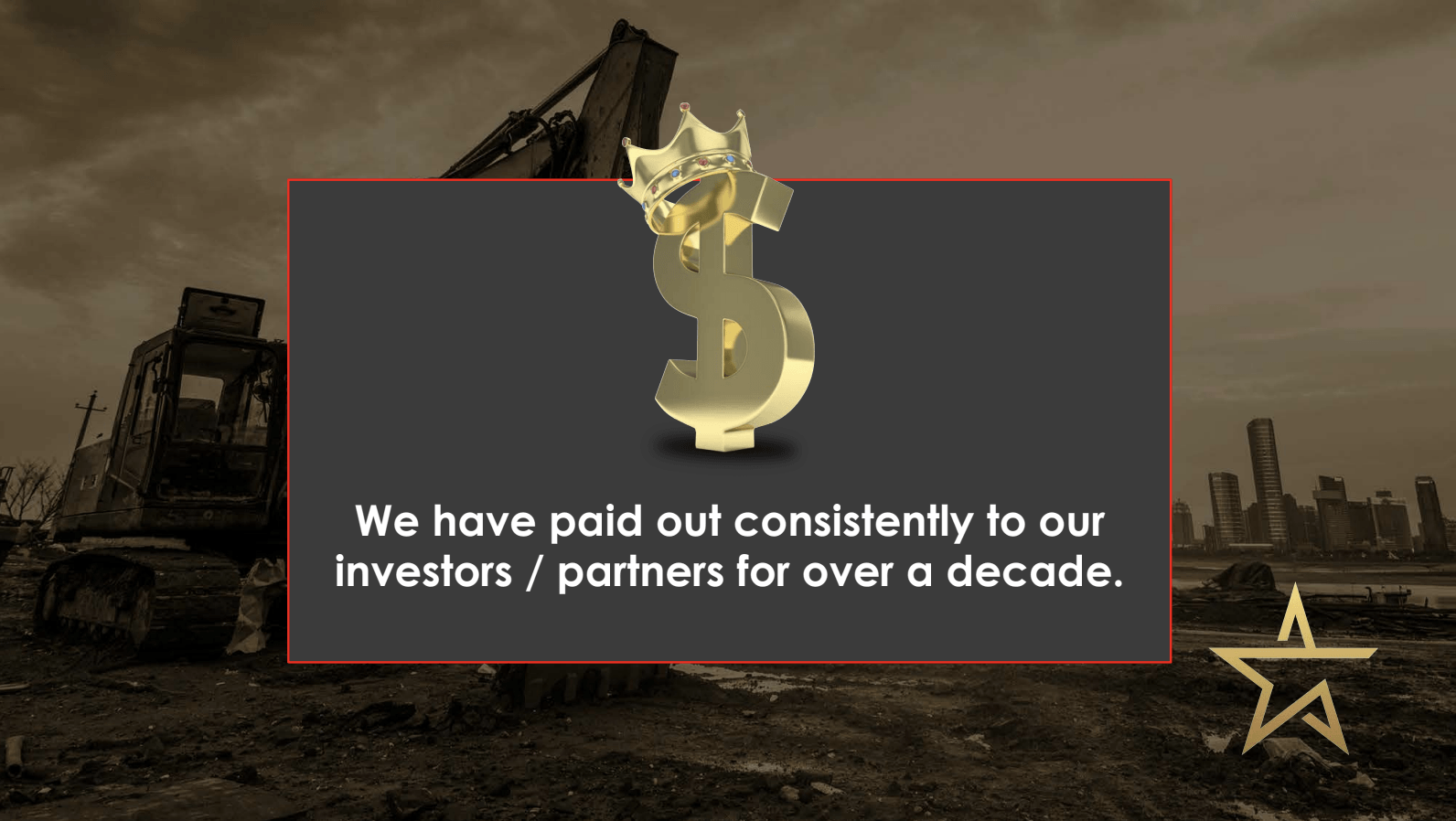LAND DEVELOPMENT
OUR CONTRACTS
WHAT MAKES THIS A UNIQUE TIME FOR HOMEOWNERS & RENTERS?
- Historically Low Interest Rates
- Mass Migration out of Big Cities & High Density properties
- More Renters & Homeowners now allowed to work from home
- Wanting COVID compliant living in less restrictive states
- Almost half a million New Yorkers left NYC during 2020 Pandemic
- Looking for a better lifestyle & more affordable areas to live
WHAT MAKES THIS A UNIQUE TIME FOR BUILDERS & DEVELOPERS?
- Home buyers are taking advantage of historically low rates
- Nationwide housing inventory is at all time low
- Less than 1.9 Months of SFR inventory Nationwide
- Home buyers are taking advantage of historically low rates
- Nationwide housing inventory is at all time low
- There’s less than 1.9 Months of SFR Inventory Nationwide
- Demand for more SFR style living, space & home offices
- Shift from Multi Family dwellings to Single Family Homes
- 2.5 Million Unit deficit for housing in the U.S.
- More Homeowners & Renters are working from home
- Homeowners & Renters are leaving High Density Cities
- Builders are starving for Shovel Ready Land
WHAT MAKES ROCKSTAR DIFFERENT?
- Pre-groundbreaking work completed by BRD Land & Investment
- Zoning and Permit approved or ready within 9 -18 months
- Acquisitions previewed by our Buyers/Builders for approval or interest
- Strong team of land acquisition Managers & Engineers
- Strong contracts - Closing only on permit approved Land
* Our Builders often bring us the Ground THEY WANT ! *
- Shovel & Permit Ready for Builders
- Strong contracts to acquire only permit approved land
frequently asked question
-
What are the risks of this deal?
While there is a massive demand for housing, approximately 5.5 million in the US, we
don’t know what the future may bring. If there was a recession, decreased demand for
housing, increased building costs and rising interest rates these could all affect the
returns of the investment. However, if there is continued demand for housing and the
builders and buying land to build homes to meet the demand this model works very
well. Based on the shortage of housing the predictions are 3-5 years to catch up with
demand.
-
What is the timeline of the fund?
This fund is “evergreen”, which means that there is no set timeline for the fund. This
provides flexibility for the manager. If the market and demand are still going strong in 7
years, the fund can continue. If demand is waning, at the discretion of the manager the
fund can be dissolved, and capital returned to investors.
-
What happens if the real estate market and demand for new housing slows down?
Principal protection is foremost. If the Fund is not producing expected profits the Fund
will be closed at the discretion of the manager and principal returned to the investors.
-
When does the investment start to earn money and how are the preferred return and profit sharing distributed?
The money invested starts to accrue the day it is received into the Fund. Profit sharing
for the quarter will be pro-rated based on the date of investment as well. The preferred
return of 10% and profit-sharing are distributed quarterly, approximately mid-month
following the quarter end. For example, Q1 payments will go out mid-April by ACH.
-
Can my shares be diluted? How much is one share?
No, you shares cannot be diluted. The value remains constant at $10, 000 and $1000 Share/ Unit.
-
What exactly does the fund do?
Rockstar Capital Fund Group is a lending fund. It partners closely with an operator that has 2
arms to their business. Buller River Development Land and Investment (BRDL) is a land
development company specializing in the creation of Permitted Real Estate lots for raw
land. This is also called Land Entitlement. They prepare raw land for building by obtaining sub divisional approval by the local municipality with all land disturbance permits in hand (i.e., Shovel Ready, dirt can be moved). Estero Development Partners is focused on the entire process of developing homes to be sold as “Build For Rent”. Demand for rental homes is high, and Estero sells a great deal of their inventory to investment groups, as well as several National Funds, REITs and Family Offices. Rockstar Capital Fund Group provides BRDL and Estero with the capital they need to grow their business, for both Land Entitlement and Build For Rent development.
-
What markets are BRDL and Estero buying and developing land in?
Charlotte, NC, Southwest Florida, Charleston, SC and Phoenix AZ (March 2022).
-
What is the minimum investment?
$10,000 and increments of 1K thereafter.
-
Is there depreciation in this fund?
Since this Fund is focused on lending, there is no depreciation. The PPM allows for
purchase of real property, such as Build For Rent. This would provide depreciation but is
not currently a part of the Fund. Additionally, raw land is not depreciable.
-
Can an investor reinvest the distributions (Dividend Reinvestment Plan)?
Not currently but we are considering setting this up in 2023. Alternatively, additional
10K shares can be purchased with distributions in a very simple process.
-
What triggers the payout of the principal invested?
Dissolution of the fund at the discretion of the manager will trigger the payout of the
principal.
-
How does an investor exit the fund?
While this is not considered a liquid investment like the stock market, the shares
purchased are redeemable. The investor, upon redemption, will receive all their original
principal back. There is a cap of 10% redemption from the fund per year. This is not an
equity deal, so the investor receives high annual cash flow anticipated to be 16%+, and
upon exit receives their original investment amount.
-
Is there leverage in the fund?
While the PPM allows for leverage the Fund does not intend to use leverage.
-
How is my capital investment protected?
Capital preservation is #1. The Fund is in first lien position on the property acquired.
Additionally, for Land Entitlement, the due diligence process is extensive, and the land
will not be purchased until multiple hurdles are met and BRDL is confident they will sell,
and they typically have a LOI from a national home builder before they start the due
diligence process, and definitely before purchasing the land.
-
What is the structure of the fund?
This is a Regulation A, 506 (c) fund. Each investor in the fund is a part owner (member) in
the entity. The entity files a partnership tax return which is a pass-through entity where
each individual owner is responsible for his/her proportionate share of the net income
of the entity each tax year. Each investor’s investment into the entity is considered a
partner or owner contribution. When the owner receives a distribution (i.e. the
preferred return or the profit sharing), these distributions are treated as a partner or
owner distributions.
-
What are the tax implications?
The distributions (preferred and profit sharing) will be treated as a return of capital.
That is the structure of the partnership - each partner's capital account on the K-1 will
show a decrease based on the distributions received the prior year. This is a common
method used in partnerships.
In addition, the partnership will also pass through any income (or loss) to the investors
on a pro-rata basis. Any income will be passive income and considered taxable. Any
income will also increase the basis in the capital account.
Based on the fund being primarily a lending fund, we do anticipate there will be income
and minimal losses. Therefore, the investor can expect some amount of passive taxable
income to be on the K-1, at ordinary rates. This income could be offset by passive losses
if available.
If the capital account (basis)is not diminished because of the ongoing income to the
fund, then the return of capital upon exit will be tax free. On the other hand, if the
capital account was decreased to zero during the investment, upon return of capital the
original principal would be taxable. The reduction of the capital account to zero is
unlikely in this Fund due to anticipated income.
In addition, the method in calculating the actual K-1 figures when preparing the annual
tax return is a separate process from the quarterly preferred returns as well as
a separate process from the profit-sharing calculation. These figures will be close, but
rarely will match exactly.
-
What is Phantom income?
Regarding any chance of phantom income, yes there could be a possibility of that.
To speak as to how that will happen, let me try and explain it this way. The method for
calculating the distributions and the method for calculating the share of net income is
different. For example, a $100,000 distribution would generate $12,000 in distributions,
at 12%.
The percent ownership for this person would be 0.0073 (assuming a total amount of
$7.5 million in contributions in the company and 55% to the preferred members). If the
same company had $1,000,000 in net income, that partners share in the taxable income
would be $7,333.33. In this case the distribution would cover it, even if there was not a
profit-sharing distribution. However, what if the net income were $3,000,000, these
partners share of taxable income would be $21,990. If there were only distributions of
$12,000 then the difference would be this phantom income as was described.
Using the same scenario, if the decision was to distribute $1.5 million of the net income
as profit sharing distributions and leave half in the company, then profit sharing
distribution for this member would be $10,995. This would create a total amount of
distributions of $22,995 and with a taxable income of $21,990, the partner would be ok.
Still using the same assumptions above, but the decision was to only distribute $1
million of the net income for profit sharing and leave the rest in the company, the
profit-sharing distribution for this member would be $7,330. Under this situation the
total distributions would be $19,330 ($12,000 + $7,330) and the taxable income would
be $21,990, creating a small amount of phantom income.

Slide title
Write your caption hereButton
Slide title
Write your caption hereButton
Slide title
Write your caption hereButton
